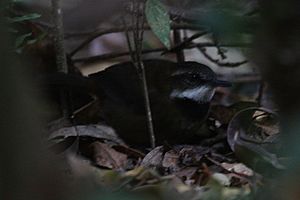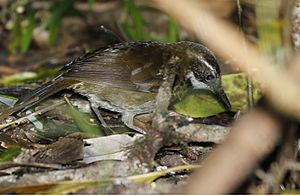Fernwren facts for kids
Quick facts for kids Fernwren |
|
|---|---|
 |
|
| Conservation status | |
| Scientific classification | |
| Genus: |
Oreoscopus
|
| Species: |
gutturalis
|
The fernwren (Oreoscopus gutturalis) is a small bird that lives only in the rainforests of northern Queensland, Australia. It's a special kind of bird because it's the only species in its group, called Oreoscopus. You can often find it in wet lowland forests and misty mountain forests.
Contents
About the Fernwren's Name
The fernwren was first discovered by a scientist named Charles Walter De Vis in 1889. He first thought it was a type of scrubwren. Later, another scientist, Alfred John North, decided it was special enough to have its own group, or genus, called Oreoscopus.
The name Oreoscopus comes from ancient Greek words. Oros means 'mountain' and scopos means 'watcher'. So, its name means 'mountain watcher'! The second part of its scientific name, gutturalis, means 'of the throat'. This is because the fernwren has a very noticeable white throat.
What Does a Fernwren Look Like?
The fernwren is a small bird, about 12 to 14 centimeters (5 to 5.5 inches) long. It has a white stripe above its eye and a white throat. Its face is dark brown, and below its white throat, it has a black patch, like a bib.
Its top feathers are dark olive-brown, and its belly is a lighter color. It also has a long, thin beak. Male and female fernwrens look very much alike. Young fernwrens are dark brown and do not have the white markings on their faces that adult birds have.
Where Fernwrens Live
You can find the fernwren in the rainforests of northeast Queensland, Australia. They usually live in areas between 300 and 1500 meters (about 1,000 to 5,000 feet) above sea-level. They are more often found higher up, above 650 meters (about 2,100 feet).
They live in places like the Paluma Range National Park and from the Tully Gorge National Park north to Cape Tribulation. Fernwrens tend to stay in one area and are quite common. Because of this, they are listed as a species of Least Concern by conservation groups.
How Fernwrens Behave
Fernwrens like to search for food in the moist leaf litter on the forest floor. They especially like shady areas in mountain rainforests. As they look for food among the fallen leaves and plants, they often bow their heads and flick their short tails.
They eat small creatures like insects and spiders, which are called arthropods. They also eat small lizards called skinks. Fernwrens have many different calls. These include high-pitched squeaks and whistles, softer chattering sounds, and a buzzing, scolding call.
Fernwren Families
Fernwrens build their nests during the breeding season, which is from July to January. Most nesting happens in October and November. Both the male and female fernwrens work together to build a dome-shaped nest.
They often hide their nests under an overhanging bank, a fallen log, or inside a small cave among ferns. The nest is made from small twigs, roots, moss, and lichen. The female usually lays two eggs. These eggs are shiny white and sometimes have small chestnut and tan spots. Each egg is about 22 millimeters (0.87 inches) long and 17 millimeters (0.67 inches) wide.
The female bird sits on the eggs for about 29 days until they hatch. After the chicks hatch, both parents feed them for about 21 to 23 days.
See also
 In Spanish: Acantiza de helechal para niños
In Spanish: Acantiza de helechal para niños



